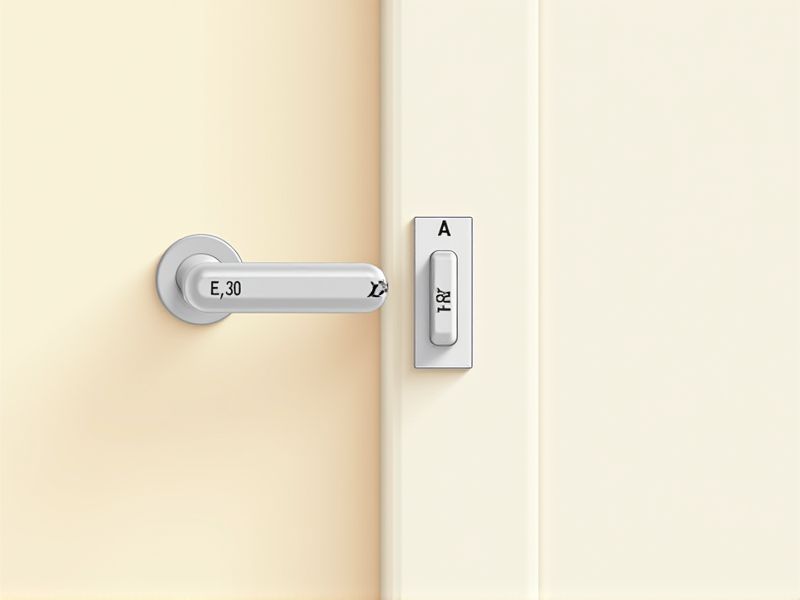
When selecting a door handle, knowing the standard dimensions ensures compatibility and ease of use. Most door handles are designed to fit doors with a thickness between 35mm and 45mm (about 1-3/8" to 1-3/4"). The typical backset--the distance from the edge of the door to the center of the handle--is usually 60mm or 70mm (2-3/8" or 2-3/4"). Additionally, the length of the handle itself often ranges between 100mm to 150mm (about 4" to 6"), providing a comfortable grip for most users.
Length Of The Handle
The standard length of a door handle typically ranges from 3 to 12 inches, ensuring a comfortable grip for users. In residential settings, a length of 6 to 8 inches is common, promoting ease of use for individuals of various heights. For accessibility standards, such as those outlined by the Americans with Disabilities Act (ADA), handles should be positioned between 34 to 48 inches from the floor. It's essential to choose a door handle length that complements your specific door type and design aesthetic while providing functionality and safety.
Diameter Of The Grip
The standard diameter of a door handle grip typically ranges from 1 to 1.5 inches (25 to 38 mm), designed to ensure comfort and ease of use. A grip within this range allows users to maintain a secure hold while minimizing the risk of hand fatigue. Ergonomics plays a crucial role, as a well-proportioned handle can accommodate various hand sizes, enhancing accessibility for everyone. When selecting door handles, consider the grip diameter to improve functionality and user experience in residential and commercial settings.
Backset Measurement
The backset measurement, typically ranging from 2-3/8 inches to 2-3/4 inches, is crucial for proper door handle installation. This distance determines the space between the edge of the door and the center of the handle or lock, affecting functionality and aesthetics. Accurate backset sizing ensures that your door handle aligns seamlessly with the latch and the doorframe, providing a secure fit. Always measure from the edge of the door before selecting a handle to guarantee compatibility with your specific door type.
Distance Between Screw Holes
The standard distance between screw holes for door handles is typically 3 inches (76 mm) for most residential applications, although variations can exist. This measurement ensures compatibility with various door types and styles, contributing to a secure fit and functionality. When selecting a door handle, it's essential to verify this distance to avoid installation issues. You can enhance the aesthetic of your space by selecting handles that match this standard distance while also complementing your door design.
Projection From The Door Surface
The standard projection of a door handle from the door surface typically ranges from 2 to 4 inches, ensuring optimal accessibility while maintaining aesthetic appeal. This measurement influences the ease of use, especially for individuals with limited mobility or dexterity challenges. When selecting a door handle, consider ergonomic designs that comply with the Americans with Disabilities Act (ADA) guidelines, which recommend that handles should be operable with one hand. Properly installed handles should allow for comfortable grip and operation without excessive force, enhancing overall functionality.
Width Of The Plate Or Rose
The standard width of a door handle's plate or rose typically ranges from 50mm to 70mm, ensuring a comfortable grip and aesthetic appeal in various settings. This measurement accommodates most hand sizes while providing adequate support for the latch mechanism. When selecting door handles, consider the thickness of your door, which is usually around 35mm to 45mm for residential applications, as this influences the fit and functionality. Your choice of handle design can also affect the overall style of your space, with finishes available in brushed nickel, chrome, or matte black to complement your interior decor.
Length Of The Spindle
The standard length of a door handle spindle typically ranges between 70mm and 90mm, catering to various door thicknesses. For instance, a spindle length of 70mm works well for standard internal doors, while a 90mm spindle is ideal for thicker external doors. Ensuring that the correct spindle length is chosen not only affects the aesthetic appeal but also the functionality and security of the door. When replacing or installing door handles, always measure your current spindle length to ensure a proper fit for your specific door type.
Clearance Between Handle And Door
The standard clearance for a door handle typically ranges from 36 to 42 inches above the finished floor, ensuring accessibility for individuals of various heights. A minimum space of 1 to 1.5 inches between the handle and the door surface is crucial to facilitate ease of operation while preventing any obstruction. For lever handles, the projection from the door should ideally be no less than 2.5 inches, allowing sufficient room for hand placement. Ensuring these measurements not only enhances usability but also contributes to compliance with accessibility standards, promoting a user-friendly environment.
Escutcheon Size
The escutcheon size for door handles typically ranges from 2 to 3 inches in diameter, essential for ensuring proper coverage of the keyhole and providing a polished look. A well-sized escutcheon enhances security by adding an extra layer of protection against tampering. When choosing a door handle, consider the escutcheon material as well; options like brass or stainless steel offer durability and aesthetic appeal. For a seamless installation, ensure your escutcheon aligns perfectly with the door's thickness, often varying from 1 3/8 to 2 inches.
Required Clearance For Operation
A standard door handle typically requires a clearance of 36 inches for optimal operation, ensuring sufficient space for accessibility. The handle height should be positioned between 34 to 48 inches from the floor to accommodate a diverse range of users, including those with disabilities. When choosing a door handle, consider options that comply with ADA guidelines, as they facilitate easier use and promote universal accessibility. Proper installation and maintenance help maintain this clearance, ensuring your door operates smoothly and safely.
